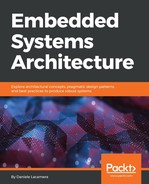Another machine-to-machine connectivity technology in constant evolution is Bluetooth. Its physical layer is based on 2.4 GHz communication to establish host/device communication, or providing the infrastructure for PAN supporting multiple protocols, including TCP/IP communication. Thanks to its longtime success and the consequent wide adoption in the market of personal computers and portable devices, Bluetooth connectivity has started to gain popularity in the universe of embedded microcontrollers, mostly due to the recent evolution of the standard in the direction of lower power consumption.
Initially designed as a wireless replacement of serial communication for devices at a close range, the classic Bluetooth technology has evolved to support integrated dedicated channels, including TCP/IP-capable network interfaces and dedicated audio and video streaming links.
A low-power variant of the protocol stack, introduced with version 4 of the standard definition, has been designed with the purpose of limiting energy consumption for embedded sensor nodes, and introduces a new set of services. A sensor device may export a Generic Attribute Profile (GATT) that can be accessed by a client (usually a host machine) to establish communication with a device. When the transceiver on the target is inactive, it consumes a small amount of power, while it is still possible to discover its attribute and initiate a GATT transfer from a client. Bluetooth is mostly used nowadays for short-range communication, to access sensor nodes from personal computers and portable devices, to exchange multimedia content with remote audio devices such as speakers, headsets, hands-free automotive voice interfaces, and in several healthcare applications, thanks to some profiles being specifically designed for this purpose.
